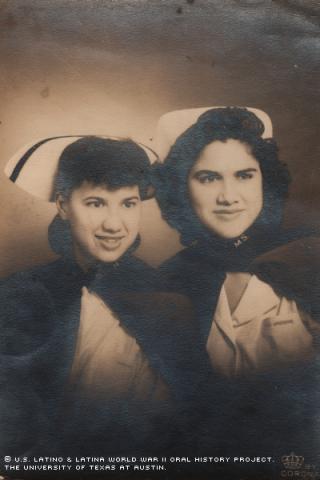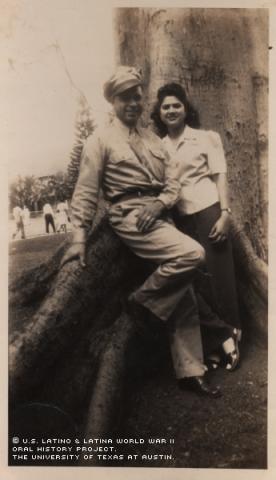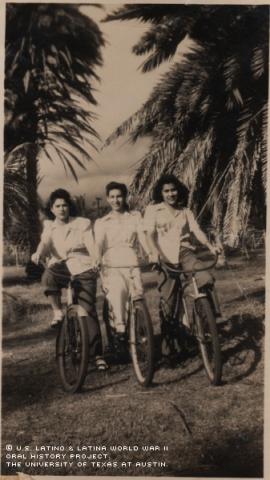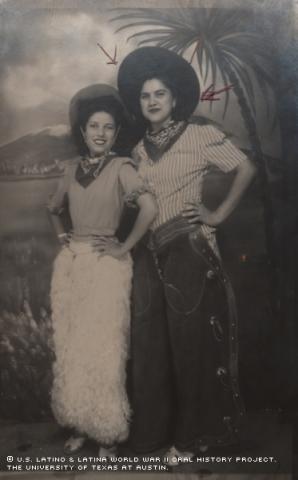



By Whitney Mizer
Eighty-two-year-old San Antonio resident Ester Arredondo Perez always worked hard to accomplish her goals, whether they were traveling the world or becoming the first Latino high school graduate in Fort Bend County, Texas.
Born April 25, 1920, in Needville, Texas, Perez grew up on a farm as one of six children amid a harsh rural environment. From the time she was six, she joined her siblings picking cotton and couldn’t attend school until October, when the crop was harvested. Even though they picked the fields between August and October each year while she attended school, she wasn't deterred from graduating.
Pervasive discrimination further added to the odds against Perez’s high school success. Relations between Latinos and members of the predominant Czech population were strained, and the school bus driver would separate both groups on the bus. Often, the Czech bus driver would leave without the Latino children having boarded.
"We would have ... to run to catch a bus," she said, noting that the distance between her house and the bus stop was about a mile. "How come he didn't wait for us?"
Her father, Carlos Arredondo, interceded when he learned of the situation, and confronted the bus driver.
"Daddy, like I say, he didn't let nobody run over him," Perez said, laughing. "He said ... oh, I'm not saying the word he said."
Carlos always stressed the importance of education. While other Latino children failed to attend school, Perez and her siblings were encouraged to do so. Most of the time, Perez sat alone in the classroom, until two boys came to sit near her one day because they wanted help with their high school Spanish class assignments. She loved high school, and took quite seriously her parents' threat of pulling her out of classes if she misbehaved.
Perez would go on to graduate from Richmond High School in 1939, becoming the first Latina to do so in the school's history.
"The Mexicanos did not believe in sending kids to school, but daddy did," she said. "I owe that to daddy."
Perez's father sent her to San Antonio after her graduation, where he believed she’d have more opportunities to use her education on the job. She lived with an uncle and worked for Steve Sash and Door Co., where she helped make cabinets before the war. During the war, she was reassigned to making lockers.
In January of 1942, she went to work for Kelly Air Force Base, which was known then as Kelly Field. At the time, the military was hiring women to replace the men going into battle.
"[T]here again, I was the first female engine repair [mechanic] at Kelly Field," she said excitedly, noting her unique status as the only Latina there, too.
Perez longed to travel overseas, so one day she visited a doctor for all the needed inoculations for traveling abroad. To satisfy her wanderlust, she volunteered for overseas duty but told her family she was being forced to go. Her mother, Francisca Mikeles Arredondo, wasn’t easily swayed.
"Mother was no fool," Perez said. Later, when her family knew traveling abroad was her decision, they viewed her as brave but foolish.
Despite their objections, Perez enjoyed the adventure of travel. In August of 1944, she traveled to Sacramento, Calif., to master engine installation, since there were no positions for engine repairmen overseas. After her training, she moved to Hawaii in November of 1944 to begin work as an engine mechanic. She and thirty-nine other women volunteers worked on aircraft intended to fly into battle.
Perez returned to San Antonio in May of 1946 to enroll in Nursing School at Baptist Memorial Hospital.
"There were just four Latinas," she said. "There again, we were segregated."
Nursing was her dream, and she was willing to endure the segregation once again to succeed.
"I love nursing. I wouldn't change my nursing. I enjoyed the mechanics -- it was something -- but I wouldn't change my nursing for nothing," Perez said.
She graduated from nursing school on August 25, 1949, and began working at Robert B. Green Hospital (now University Hospital) the following September. She worked from 11 p.m. to sunup in the men's ward, where there were about 23 men.
"I always think now, how did I do it?" Perez said. "I was the only nurse -- all by myself with 23 patients. But I did it."
One of the reasons she was hired was the immediate need for nurses. Her unit was the first one at University Hospital in 1968 when the new building opened.
Her advice to today's young people is to persevere and never give up on their goals. Even though she faced discrimination, she didn’t allow that to stop her from reaching for her dreams, and attributes any early failures to youth and inexperience rather than environmental obstacles.
She notes that some people, including her own sons, believe Latinos have often allowed themselves to feel inferior when they are discriminated against.
"My sons say that it was our fault. We brought it on ourselves, which is true," she said. "But you let it go. You shouldn't let people do that to you."
Now a widow, Perez lives in San Antonio. She met her late husband, Edward Perez, who also worked at Kelly Field, at her nursing school roommate's wedding. They married in 1950 and had three children before his death in 1989.
"Would I change my life? I think I would change it some, but then I wouldn't have these three beautiful sons," Perez said.
Mr. Perez was interviewed in San Antonio, Texas, on May 23, 2002, by Erika Martinez.

